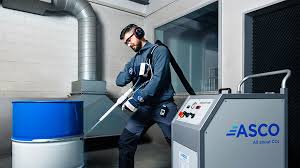 Business
Business
Why ISO 13485 Training Is Your Ticket to Mastering Medical Device Design
- by Azik
You’re a design and development engineer, knee-deep in schematics, prototypes, and the thrill of creating something that could save lives. But then, someone mentions ISO 13485, and suddenly, it feels like the rulebook just got a lot thicker. Don’t worry—ISO 13485 training isn’t about memorizing a dusty standard; it’s about giving you the tools to make your designs safer, smarter, and ready for the real world. Let’s break it down and see why this training is a game-changer for engineers like you.
What’s ISO 13485, Anyway?
ISO 13485 is the gold standard for quality management in medical device manufacturing. Think of it as a blueprint that ensures every device you design—from pacemakers to surgical tools—meets strict safety and performance requirements. It’s not just a checkbox for regulators; it’s a mindset that keeps patient safety first. For design engineers, ISO 13485 is your guardrail, guiding you through the chaos of innovation to create products that work flawlessly under scrutiny.
Why should you care? Because regulators like the FDA and European authorities lean heavily on this standard. Without it, your groundbreaking design might never make it to market. Training in ISO 13485 equips you to navigate its requirements, from risk management to design controls, without losing your creative edge.
The Engineer’s Edge: Why Training Matters
Let’s be real: you didn’t become an engineer to drown in paperwork. But here’s the thing—ISO 13485 training isn’t about bureaucracy; it’s about sharpening your skills. It teaches you how to integrate quality into every stage of design, from brainstorming to final validation. You’ll learn to spot risks early, document your process like a pro, and avoid costly rework. Sounds practical, right?
Training also bridges the gap between your technical expertise and the regulatory world. You might be a wizard with CAD software, but if your design documentation doesn’t meet ISO 13485 standards, it’s back to square one. A good training program—like those offered by organizations such as BSI or TÜV SÜD—shows you how to balance innovation with compliance. Plus, it’s a chance to network with other engineers and swap war stories about navigating the medical device landscape.
- Real-world skills: Learn to create design inputs and outputs that pass audits with flying colors.
- Risk management mastery: Get hands-on with tools like FMEA (Failure Modes and Effects Analysis) to catch issues before they snowball.
- Team synergy: Understand how your work fits into the broader quality management system, making collaboration smoother.
Busting the Boredom Myth
Now, I know what you’re thinking: “Training sounds like a snooze-fest.” Fair point—nobody wants to sit through endless PowerPoint slides. But modern ISO 13485 training is different. Many programs are interactive, blending case studies, group exercises, and even virtual simulations. Imagine dissecting a real-world design failure to see where it went wrong or role-playing an audit to test your documentation skills. It’s less about lectures and more about rolling up your sleeves.
Some courses even tie in current trends. For instance, with AI and IoT creeping into medical devices, training might cover how ISO 13485 applies to software-driven products. You could explore how to validate a smart insulin pump or ensure a wearable device complies with cybersecurity requirements. It’s relevant, it’s engaging, and it’s directly applicable to your day-to-day work.
The Emotional Payoff: Confidence and Pride
Let’s get a bit personal for a second. As an engineer, there’s nothing like the rush of seeing your design come to life. But there’s also that nagging worry: “What if I missed something?” ISO 13485 training quiets that voice. It gives you the confidence to know your work meets the highest standards. You’re not just building devices; you’re building trust—with regulators, clinicians, and patients.
There’s pride in that, too. When you know your design has been vetted through a rigorous quality system, you can stand behind it. You’re not just an engineer; you’re a guardian of safety. That’s the kind of thing that makes the long hours and tough deadlines worth it.
How Training Fits into Your Crazy Schedule
You’re busy. Between prototyping, testing, and putting out fires, finding time for training feels like squeezing water from a stone. The good news? ISO 13485 training comes in flexible formats. Online courses let you learn at your own pace—perfect for those late-night study sessions. In-person workshops, often spanning a couple of days, offer immersive experiences if you prefer face-to-face learning. Some companies even bring trainers on-site, tailoring the content to your team’s specific projects.
Here’s a quick rundown of options:
- Online self-paced: Platforms like Udemy or ComplianceOnline offer modules you can tackle whenever.
- Live virtual: Interactive sessions with real-time Q&A, often hosted by experts from regulatory bodies.
- In-person: Intensive bootcamps that dive deep into practical applications, ideal for hands-on learners.
Pro tip: Check if your employer offers reimbursement. Many companies see ISO 13485 training as an investment in their team’s success. And honestly, who doesn’t love a perk like that?
A Quick Detour: Why This Matters Beyond the Job
You know what’s cool about ISO 13485 training? It’s not just about your current project. The skills you pick up—risk analysis, process optimization, clear documentation—are transferable. They make you a better engineer, period. Whether you’re designing medical devices or pivoting to another industry, like aerospace or automotive, these principles apply. Quality management is universal, and that makes you a hot commodity in the job market.
Plus, there’s a bigger picture. Medical devices aren’t just products; they’re lifelines. Your work could help a surgeon save a life or give a patient a second chance. ISO 13485 training ensures you’re not just meeting standards but contributing to something meaningful. That’s the kind of legacy that sticks with you.
Overcoming the Learning Curve
Okay, let’s address the elephant in the room: ISO 13485 can feel overwhelming at first. The standard is dense, and terms like “design verification” and “process validation” might sound like jargon soup. But good training breaks it down into bite-sized pieces. You don’t need to be a regulatory expert to get it—just an engineer who’s willing to learn.
Start with a beginner-friendly course that covers the basics, then move to advanced topics like integrating ISO 13485 with ISO 14971 for risk management. Many programs use analogies to make concepts stick. For example, think of design controls as a recipe: you need clear ingredients (inputs), a step-by-step method (process), and a taste test (validation) to ensure the dish is perfect. See? It’s not rocket science—it’s just structured problem-solving.
What to Look for in a Training Program
Not all ISO 13485 training is created equal. You want a program that’s practical, engaging, and led by instructors who’ve been in the trenches. Here are some tips to pick the right one:
- Industry expertise: Look for trainers with experience in medical device design, not just general quality management.
- Hands-on focus: Choose courses with exercises, like drafting a design history file or conducting a mock audit.
- Accreditation: Programs certified by bodies like IRCA or Exemplar Global carry more weight.
- Up-to-date content: The medical device world evolves fast, so ensure the course reflects the latest regulations, like the EU MDR.
A quick Google search for “ISO 13485 training for engineers” will pull up reputable providers. BSI, for instance, offers courses tailored to design teams, while MedTech webinars provide bite-sized sessions for busy professionals. Whatever you choose, make sure it fits your learning style and career goals.
Wrapping It Up: Your Next Step
So, where do you go from here? ISO 13485 training isn’t just a nice-to-have; it’s a must for any design and development engineer serious about their craft. It’s your chance to level up, streamline your workflow, and make a real impact in the medical device world. You’ll walk away with practical skills, newfound confidence, and maybe even a few bragging rights.
Why wait? Start exploring training options today. Talk to your manager, browse online courses, or reach out to colleagues who’ve been through it. The sooner you get started, the sooner you’ll be designing devices that don’t just meet standards—they set them. And isn’t that the kind of engineer you want to be?









